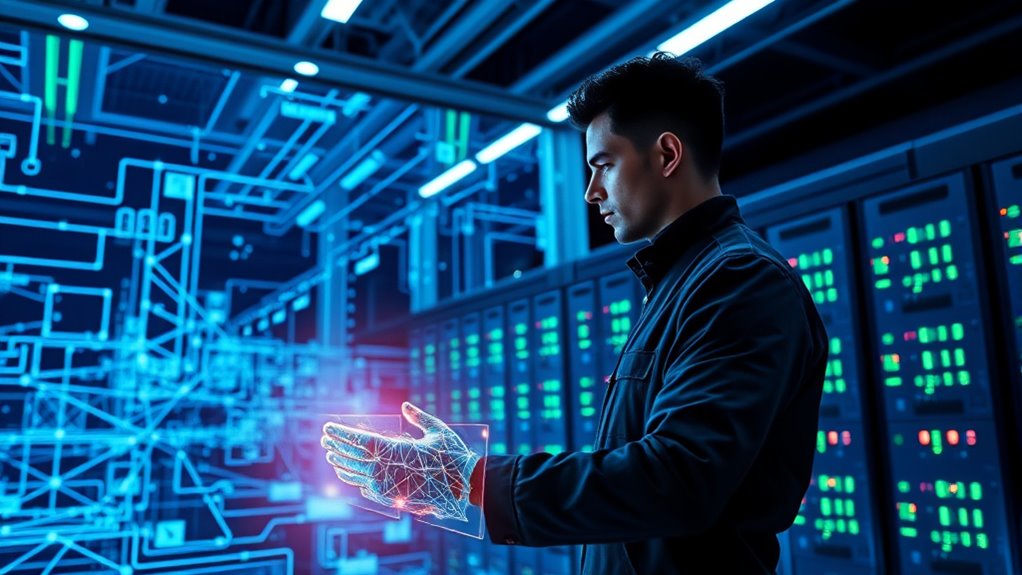AI plays a crucial role in securing smart grid systems by providing real-time threat detection, predictive analytics, and automated responses to cyber and physical threats. It continuously monitors data from meters, sensors, and control systems, helping you identify abnormal patterns early. AI also facilitates collaboration across the grid, enhancing threat containment and response coordination. By strengthening cybersecurity and optimizing operations, AI keeps your smart grid resilient—discover how these innovations can further protect your infrastructure.
Key Takeaways
- AI continuously monitors grid data to detect cyber threats, physical intrusions, and equipment failures early through anomaly detection.
- Collaborative AI networks share security insights across the grid for rapid, coordinated threat containment.
- Advanced AI cybersecurity measures predict vulnerabilities, strengthen access controls, and defend against adversarial attacks.
- AI optimizes grid performance with predictive maintenance, load forecasting, and real-time system adjustments for resilience.
- Robust data infrastructure enables AI-driven situational awareness, automating responses and reducing human error in security management.

How can artificial intelligence revolutionize the security of smart grid systems? By transforming how you detect, respond to, and prevent threats, AI offers a proactive approach that surpasses traditional security methods. It continuously analyzes data from smart meters, substations, and grid sensors to spot abnormal patterns indicating cyber-attacks, physical intrusions, or equipment failures. Machine learning models establish baseline behavior for grid operations, so when real-time data deviates unexpectedly, you can identify potential issues early. This early detection allows you to act swiftly, minimizing damage and disruptions.
AI-driven threat detection isn’t just reactive; it’s predictive. It anticipates vulnerabilities and orchestrates coordinated responses to cyber threats, reducing downtime and operational impacts. Automated response systems can initiate countermeasures almost instantly upon detecting a threat, whether that means isolating compromised parts, adjusting operational parameters, or triggering alerts. These systems work in tandem within collaborative AI networks that share security insights across the entire grid, giving you a holistic and real-time view of security status. Such collaboration enhances your ability to contain threats swiftly and effectively, preventing them from spreading or escalating.
AI enables rapid, coordinated responses to threats, sharing insights across the grid for comprehensive, real-time security management.
You also benefit from AI-enhanced cybersecurity measures that strengthen your defenses. AI assists in predicting potential vulnerabilities before they’re exploited, enabling preemptive actions. Centralized AI-driven threat management helps you oversee control systems more efficiently, while advanced encryption and secure communication protocols safeguard your data transmissions. Access controls fortified with AI monitoring prevent unauthorized operations and insider threats, adding an extra layer of security. However, you must also remain aware of AI’s risks—adversarial attacks can target AI models themselves, so developing robust, attack-resistant algorithms becomes essential for maintaining your grid’s security. Additionally, implementing AI security measures ensures your defenses adapt to evolving cyber threats effectively. Incorporating robust machine learning models can help defend against adversarial attacks targeting AI systems.
Implementing AI in your smart grid doesn’t just improve security; it also optimizes overall grid performance. AI enhances load forecasting accuracy, helping you plan generation and balance loads more efficiently. It simulates renewable energy supply based on weather data, ensuring better integration of variable resources. Real-time analytics allow you to optimize voltage levels and phase balancing at substations, improving energy quality and flow. Additionally, AI-driven predictive maintenance reduces downtime by identifying potential failures before they occur, saving costs and reducing service interruptions. Long-term planning benefits from AI’s ability to model energy demand, increasing your grid’s resilience and capacity.
For AI to be effective, you need extensive data collection from diverse sources—smart meters, sensors, and control systems. Infrastructure advancements like big data platforms, cloud computing, and collaborative AI frameworks support this data-driven approach. Machine learning models help compress and prioritize vast data streams, enabling quicker decision-making. Analyzing multi-source data provides you with a comprehensive situational awareness, helping you respond faster and more accurately. Ultimately, AI moves your smart grid toward automation, reducing human error and increasing responsiveness to disturbances, making your system more resilient and secure.
Frequently Asked Questions
How Does AI Detect Zero-Day Cyber Threats in Smart Grids?
You want to understand how AI detects zero-day cyber threats. It analyzes vast data from the grid to identify unusual patterns or anomalies that indicate potential threats. AI models like machine learning and deep learning adapt over time, recognizing new attack signatures. By continuously learning and using techniques like RNNs and hybrid models, AI can spot emerging threats in real-time, helping you respond quickly and strengthen your security defenses.
What Are the Privacy Concerns With AI Monitoring Smart Grid Data?
You might find it alarming that smart meters can reveal household behaviors through energy patterns, raising serious privacy concerns. AI monitoring enhances system efficiency but also risks exposing your personal data to unauthorized access or inference. You could lose control over how your information is shared or used, especially if policies lack transparency. Protecting your privacy requires careful data management and clear regulations to prevent misuse and safeguard your household details.
How Scalable Is AI Technology for Large-Scale Smart Grid Deployment?
You might wonder how scalable AI technology is for large-scale smart grid deployment. It’s quite capable, as it leverages cloud and edge architectures to handle vast, diverse data, supporting real-time processing and autonomous control. However, you’ll face challenges like integrating with outdated infrastructure, managing high data volumes, and ensuring cybersecurity. Overall, with robust infrastructure upgrades and advanced algorithms, AI can effectively scale to meet the demands of extensive smart grid systems.
Can AI Adapt to Evolving Cyber-Attack Techniques Automatically?
You wonder if AI can automatically adapt to evolving cyber-attack techniques. The answer is yes; AI systems are designed with learning and adaptation capabilities that let them analyze new threats in real-time. By continuously training on fresh data and recognizing subtle anomalies, AI can identify emerging attack patterns and adjust defenses proactively. This ongoing adaptation helps protect your systems against sophisticated, changing cyber threats without needing constant manual updates.
What Are the Cost Implications of Implementing AI for Grid Security?
You need to take into account that implementing AI for grid security involves significant costs. Development expenses can range from $50k to over $500k, plus ongoing infrastructure costs like $23,622 monthly on platforms such as AWS. You’ll also face costs for integrating cybersecurity measures, staff training, and compliance with evolving regulations. While these investments might increase upfront, they can lead to long-term savings by preventing cyber threats and enhancing grid reliability.
Conclusion
By leveraging AI, you can markedly enhance the security of smart grid systems, protecting critical infrastructure from evolving threats. Did you know that cyberattacks on energy grids increased by over 60% last year? Staying ahead means embracing AI-driven solutions that detect and respond to threats in real time. Don’t wait for a breach—empower your smart grid with AI today and safeguard your community’s energy future.











